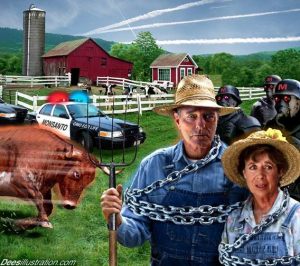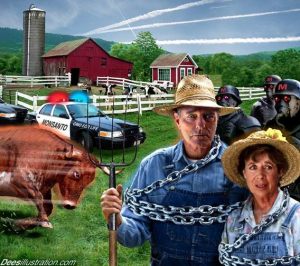 As you may know the US government is trying to pass a law, HR2749, which is about imposing totalitarian control on the food supply (such as mandating GMO-food) and restricting anything natural or healthy, such as access to supplements or even any natural food. Our health and very lives and the lives of our children depend on this being stopped. This is not an exaggeration. Our food supply will be placed in the hands of large factory farms and conglomerates like Monsanto who’s only objective is profits.
As you may know the US government is trying to pass a law, HR2749, which is about imposing totalitarian control on the food supply (such as mandating GMO-food) and restricting anything natural or healthy, such as access to supplements or even any natural food. Our health and very lives and the lives of our children depend on this being stopped. This is not an exaggeration. Our food supply will be placed in the hands of large factory farms and conglomerates like Monsanto who’s only objective is profits.
Super Human Radio, 2528 Glen Eagle Dr, Louisville, KY 40222, USA

 Tuesday, September 1, 2009 at 11:31PM
Tuesday, September 1, 2009 at 11:31PM

 Mr. Hentges is a 1992 graduate of the University of Texas with a juris doctorate from the School of Law and a Master of Public Affairs from the Lyndon B. Johnson School of Public Affairs. He is a 1987 graduate of Oklahoma State University with a bachelor of science in agricultural economics.
Mr. Hentges is a 1992 graduate of the University of Texas with a juris doctorate from the School of Law and a Master of Public Affairs from the Lyndon B. Johnson School of Public Affairs. He is a 1987 graduate of Oklahoma State University with a bachelor of science in agricultural economics. “The first thing they did when they got the authority to write rules… was to grant themselves the authority to conduct warrantless searches. Wisconsin is in the process of coercing farmers and backyard producers … into NAIS, and the accompanying Premises ID program, by threatening to withhold any of the licenses they control.” Paul Griepentrog
“The first thing they did when they got the authority to write rules… was to grant themselves the authority to conduct warrantless searches. Wisconsin is in the process of coercing farmers and backyard producers … into NAIS, and the accompanying Premises ID program, by threatening to withhold any of the licenses they control.” Paul Griepentrog Although there is a bill in Wisconsin which would restore voluntary participation I feel it is nothing more than an attempt at political redemption by the same people who passed the mandatory bill to begin with, in that they are fully aware that this bills will be sent to the House Ag committee and never see the light of day. This is merely political posturing…. The house, senate and government are all controlled by Democrats. This may be nothing more than a smoke screen while they make mandatory phase II which is the tagging and chipping, which can’t be done unless you have a Premises ID.
Although there is a bill in Wisconsin which would restore voluntary participation I feel it is nothing more than an attempt at political redemption by the same people who passed the mandatory bill to begin with, in that they are fully aware that this bills will be sent to the House Ag committee and never see the light of day. This is merely political posturing…. The house, senate and government are all controlled by Democrats. This may be nothing more than a smoke screen while they make mandatory phase II which is the tagging and chipping, which can’t be done unless you have a Premises ID. A decision by U.S. District Judge Rosemary Collyer, located in the Washington District of Criminals, throwing out a lawsuit brought by Farm to Consumer Legal Defense Fund (FCLDF)
A decision by U.S. District Judge Rosemary Collyer, located in the Washington District of Criminals, throwing out a lawsuit brought by Farm to Consumer Legal Defense Fund (FCLDF)